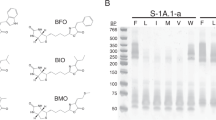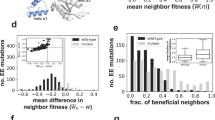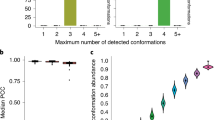Abstract
As the raw material for evolution, arbitrary RNA sequences represent the baseline for RNA structure formation and a standard to which evolved structures can be compared. Here, we set out to probe, using physical and chemical methods, the structural properties of RNAs having randomly generated oligonucleotide sequences that were of sufficient length and information content to encode complex, functional folds, yet were unbiased by either genealogical or functional constraints. Typically, these unevolved, nonfunctional RNAs had sequence-specific secondary structure configurations and compact magnesium-dependent conformational states comparable to those of evolved RNA isolates. But unlike evolved sequences, arbitrary sequences were prone to having multiple competing conformations. Thus, for RNAs the size of small ribozymes, natural selection seems necessary to achieve uniquely folding sequences, but not to account for the well-ordered secondary structures and overall compactness observed in nature.
This is a preview of subscription content, access via your institution
Access options
Subscribe to this journal
Receive 12 print issues and online access
$189.00 per year
only $15.75 per issue
Buy this article
- Purchase on Springer Link
- Instant access to full article PDF
Prices may be subject to local taxes which are calculated during checkout



Similar content being viewed by others
References
Holley, R.W. et al. Structure of a ribonucleic acid. Science 147, 1462–1465 (1965).
Fresco, J.R. From DNA melting profiles to tRNA crystals and RNA chaperones. in RNA Structure and Function (ed. Grunberg-Manago, M.) 1–35 (Cold Spring Harbor Laboratory Press, Cold Spring Harbor, New York, USA, 1998).
Xia, T. et al. Thermodynamic parameters for an expanded nearest-neighbor model for formation of RNA duplexes with Watson-Crick base pairs. Biochemistry 37, 14719–14735 (1998).
Batey, R.T., Rambo, R.P. & Doudna, J.A. Tertiary motifs in RNA structure and folding. Angew. Chem. Int. Edn. Engl. 38, 2326–2343 (1999).
Buchmueller, K.L. & Weeks, K.M. Near native structure in an RNA collapsed state. Biochemistry 42, 13869–13878 (2003).
Heilman-Miller, S.L., Thirumalai, D. & Woodson, S.A. Role of counterion condensation in folding of the Tetrahymena ribozyme I. Equilibrium stabilization by cations. J. Mol. Biol. 306, 1157–1166 (2001).
Heilman-Miller, S.L., Pan, J., Thirumalai, D. & Woodson, S.A. Role of counterion condensation in folding of the Tetrahymena ribozyme II. Counterion-dependence of folding kinetics. J. Mol. Biol. 309, 57–68 (2001).
Doty, P., Boedtker, J.R., Fresco, J.R. & Haselkorn, M.L. Secondary structure in ribonucleic acids. Proc. Natl. Acad. Sci. USA 45, 482–499 (1959).
Fresco, J.R., Alberts, B.M. & Doty, P. Some molecular details of the secondary structure of ribonucleic acid. Nature 188, 98–101 (1960).
Schultes, E.A., Hraber, P.T. & LaBean, T.H. Estimating the contributions of selection and self-organization in RNA secondary structure. J. Mol. Evol. 49, 76–83 (1999).
Seffens, W. & Digby, D. mRNAs have greater negative folding free energies than shuffled or codon choice randomized sequences. Nucleic Acids Res. 27, 1578–1584 (1999).
Higgs, P.G. RNA secondary structure: Physical and computational aspects. Q. Rev. Biophys. 33, 199–253 (2000).
Le, S.Y., Zhang, K.Z. & Maizel, J.V. RNA molecules with structure dependent functions are uniquely folded. Nucleic Acids Res. 30, 3574–3582 (2002).
Clote, P., Ferre, F., Kranakis, E. & Krizanc, D. Structural RNA has lower folding energy than random RNA of the same dinucleotide frequency. RNA 11, 578–591 (2005).
Shi, H.J. & Moore, P.B. The crystal structure of yeast phenylalanine tRNA at 1.93 angstrom resolution: A classic structure revisited. RNA 6, 1091–1105 (2000).
Ferre-D'Amare, A.R., Zhou, K. & Doudna, J.A. Crystal structure of a hepatitis delta virus ribozyme. Nature 395, 567–574 (1998).
Cate, J.H. et al. Crystal structure of a group I ribozyme domain: Principles of RNA packing. Science 273, 1678–1685 (1996).
Ekland, E.H., Szostak, J.W. & Bartel, D.P. Structurally complex and highly-active RNA ligases derived from random RNA sequences. Science 269, 364–370 (1995).
Schultes, E.A. & Bartel, D.P. One sequence, two ribozymes: Implications for the emergence of new ribozyme folds. Science 289, 448–452 (2000).
Juneau, K. & Cech, T.R. In vitro selection of RNAs with increased tertiary structure stability. RNA 5, 1119–1129 (1999).
Uhlenbeck, O.C. Keeping RNA happy. RNA 1, 4–6 (1995).
Lilley, D.M. Analysis of global conformation of branched RNA species using electrophoresis and fluorescence. Methods Enzymol. 317, 368–393 (2000).
Philo, J.S. An improved function for fitting sedimentation velocity data for low-molecular-weight solutes. Biophys. J. 72, 435–444 (1997).
Fang, X. et al. Mg2+-dependent compaction and folding of yeast tRNAPhe and the catalytic domain of the B. subtilis RNase P RNA determined by small-angle X-ray scattering. Biochemistry 39, 11107–11113 (2000).
Brown, R.S., Dewen, J.C. & Klug, A. Crystallographic and biochemical investigation of the lead(II)-catalyzed hydrolysis of the yeast phenylalanine tRNA. Biochemistry 24, 4785–4801 (1985).
Krzyzosiak, W.J. et al. Characterization of the lead(II)-induced cleavages in tRNAs in solution and effect of the Y-base removal in yeast tRNAPhe. Biochemistry 27, 5771–5777 (1988).
Matysiak, M., Wrzesinski, J. & Ciesiolka, J. Sequential folding of the genomic ribozyme of the hepatitis delta virus: Structural analysis of RNA transcription intermediates. J. Mol. Biol. 291, 283–294 (1999).
Mathews, D.H., Sabina, J., Zucker, M. & Turner, H. Expanded sequence dependence of thermodynamic parameters provides robust prediction of RNA secondary structure. J. Mol. Biol. 288, 911–940 (1999).
Schultes, E.A., LaBean, T.H. & Hraber, P.T. A parameterization of RNA sequence space. Complexity 4, 61–71 (1999).
Go, N. Theoretical studies of protein folding. Annu. Rev. Biophys. Bioeng. 12, 183–210 (1983).
Nissen, P., Ippolito, J.A., Ban, N., Moore, P.B. & Steitz, T.A. RNA tertiary interactions in the large ribosomal subunit: The A-minor motif. Proc. Natl. Acad. Sci. USA 98, 4899–4903 (2001).
Battle, D.J. & Doudna, J.A. Specificity of RNA-RNA helix recognition. Proc. Natl. Acad. Sci. USA 99, 11676–11681 (2002).
Hecht, M.H., Das, A., Go, A., Bradley, L.H. & Wei, Y.N. De novo proteins from designed combinatorial libraries. Protein Sci. 13, 1711–1723 (2004).
Prijambada, I.D. et al. Solubility of artificial proteins with random sequences. FEBS Lett. 382, 21–25 (1996).
Davidson, A.R., Liumb, K.J. & Sauer, R.T. Cooperatively folded proteins in random sequence libraries. Nat. Struct. Biol. 2, 856–864 (1995).
Davidson, A.R. & Sauer, R.T. Folded proteins occur frequently in libraries of random amino acid sequences. Proc. Natl. Acad. Sci. USA 91, 2146–2150 (1994).
Wei, Y.N. & Hecht, M.H. Enzyme-like proteins from an unselected library of designed amino acid sequences. Protein Eng. Des. Sel. 17, 67–75 (2004).
Mohanty, U. & McLaughlin, L.W. On the characteristics of migration of oligomeric DNA in polyacrylamide gels and in free solution. Annu. Rev. Phys. Chem. 52, 93–106 (2001).
Bloomfield, V., Crothers, D.A. & Tinoco, I. Physical Chemistry of Nucleic Acids (Harper and Row, New York, USA, 1974).
Fernandes, M.X., Ortega, A., Lopez Martinez, M.C. & Garcia de la Torre, J. Calculation of hydrodynamic properties of small nucleic acids from their atomic structure. Nucleic Acids Res. 30, 1782–1788 (2002).
Acknowledgements
We thank U. Müller, J.G. Ruby, M.S. Lawrence and J.S. Philo for comments on the manuscript; P. Hraber and M. Deras for computational assistance; V. Carey for statistical consultation; and R. Burton, G. Hersch and R. Sauer for use of the XL-A ultracentrifuge. This work was supported by grants from the US National Institutes of Health to D.P.B, from the Medical Foundation to E.A.S and from the US National Science Foundation to A.S. and U.M.
Author information
Authors and Affiliations
Corresponding author
Ethics declarations
Competing interests
The authors declare no competing financial interests.
Supplementary information
Supplementary Fig. 1
Evolved and arbitrary RNA sequences (PDF 44 kb)
Supplementary Fig. 2
Mapping lead-induced cleavage coefficients onto known or predicted secondary structures for evolved and arbitrary RNA sequences (PDF 611 kb)
Supplementary Table 1
Estimated effective size and Stokes radii of folded RNAs (PDF 52 kb)
Supplementary Table 2
Sedimentation coefficients and fitted molecular masses (PDF 57 kb)
Rights and permissions
About this article
Cite this article
Schultes, E., Spasic, A., Mohanty, U. et al. Compact and ordered collapse of randomly generated RNA sequences. Nat Struct Mol Biol 12, 1130–1136 (2005). https://doi.org/10.1038/nsmb1014
Received:
Accepted:
Published:
Issue Date:
DOI: https://doi.org/10.1038/nsmb1014
This article is cited by
-
Identification and characterization of novel conserved RNA structures in Drosophila
BMC Genomics (2018)
-
Structure and function of long noncoding RNAs in epigenetic regulation
Nature Structural & Molecular Biology (2013)
-
Functional complexity and regulation through RNA dynamics
Nature (2012)
-
The ancient history of the structure of ribonuclease P and the early origins of Archaea
BMC Bioinformatics (2010)
-
Isolation and Characterization of a Burkholderia sp. USM (JCM15050) Capable of Producing Polyhydroxyalkanoate (PHA) from Triglycerides, Fatty Acids and Glycerols
Journal of Polymers and the Environment (2010)



